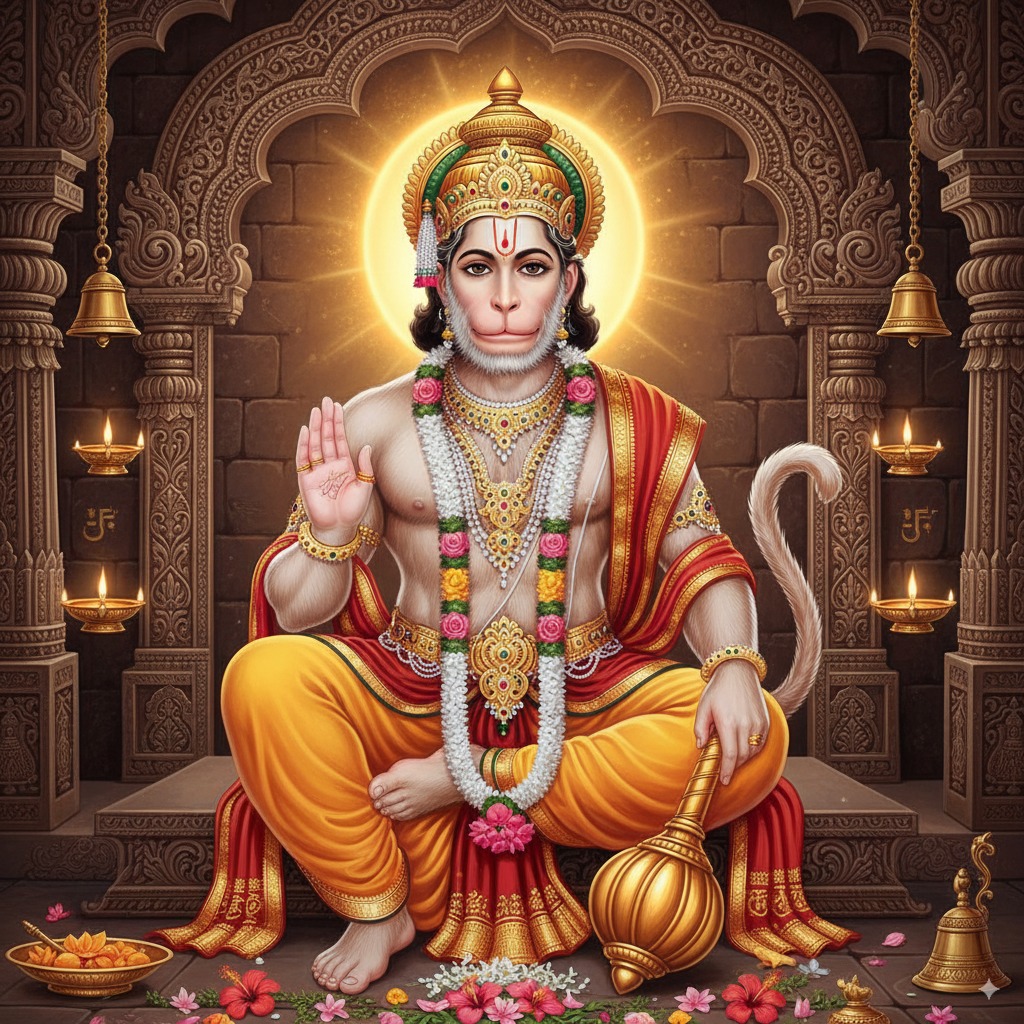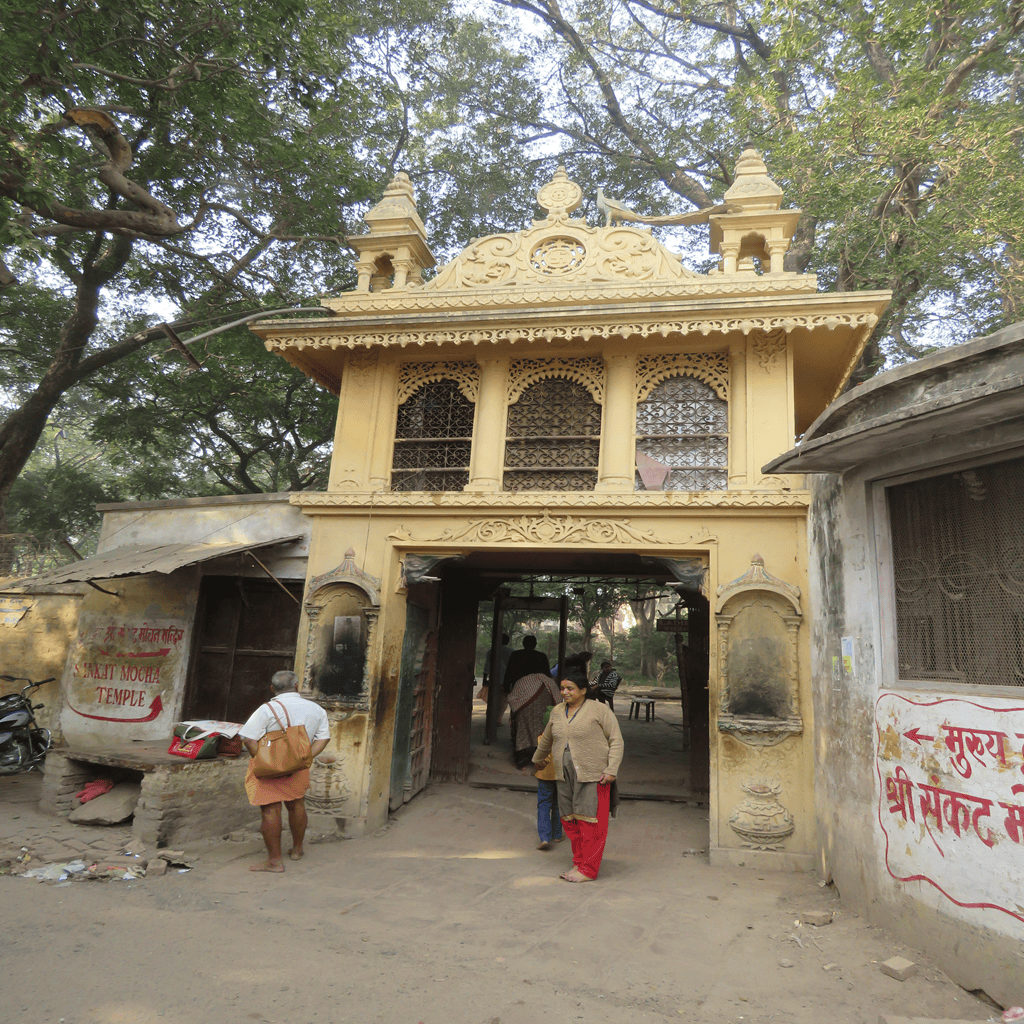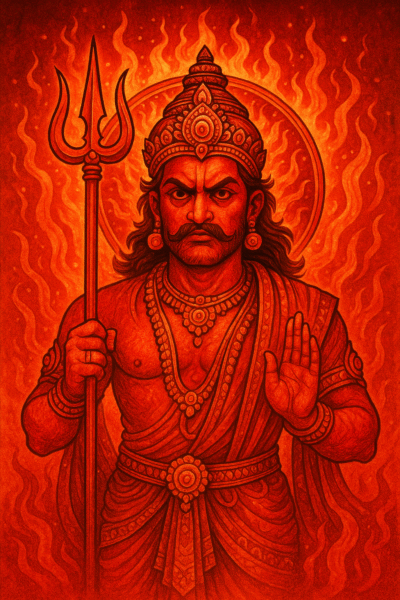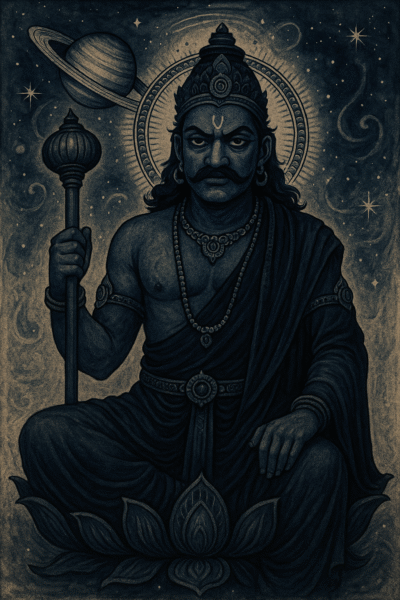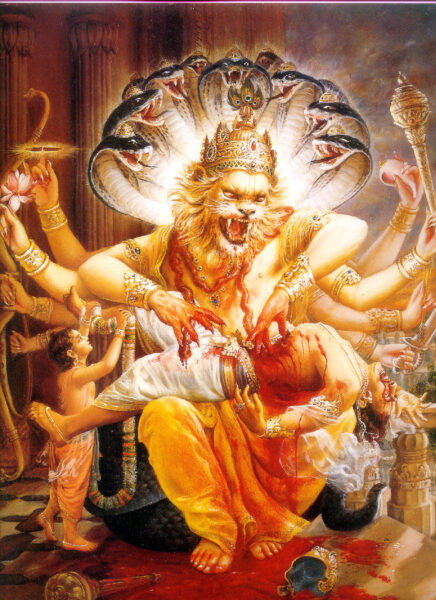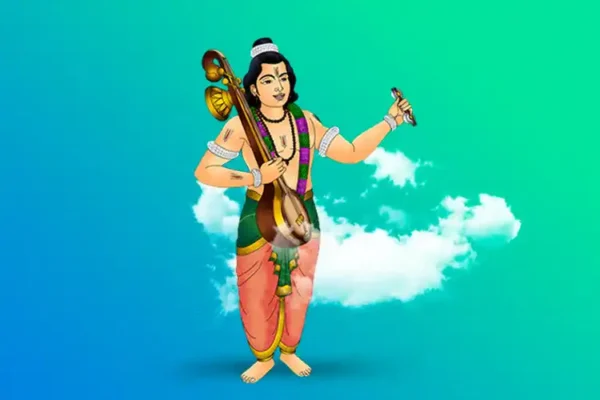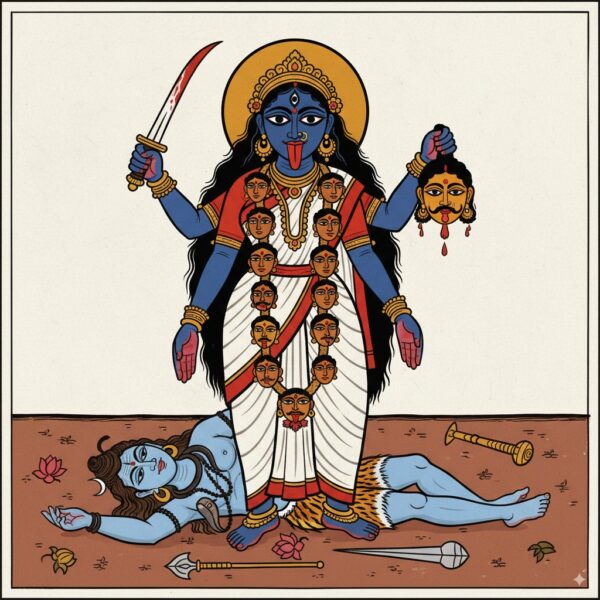Lord Hanuman - The Divine Devotee and Protector
Lord Hanuman, revered as Bajrangbali (The Mighty One) and Maruti (Son of Wind), stands as one of the most beloved and powerful deities in Hinduism. Known for his unwavering devotion to Lord Rama, incredible strength, and protective nature, Hanuman embodies the perfect devotee and represents courage, service, and divine protection.
Introduction
As the devoted follower of Lord Rama and one of the central figures in the Ramayana, Hanuman represents the highest ideals of devotion, service, and strength. Born as the son of Vayu (the Wind God) and blessed with extraordinary powers, he is revered as a symbol of courage, loyalty, and selfless service. Hanuman is not just a deity but the embodiment of the perfect devotee who shows that through complete surrender and service to the divine, one can achieve the highest spiritual states while remaining humble and accessible to all.
Physical Attributes & Iconography
Lord Hanuman's distinctive appearance carries deep spiritual symbolism:
The Divine Form
- Monkey Form (Vanara): Represents the evolved soul that has transcended animal instincts while retaining natural strength and agility.
- Orange/Red Complexion: Symbolizes purity, spiritual fire, and the life-giving energy of the sun.
- Muscular Physique: Represents immense physical and spiritual strength available to sincere devotees.
- Long Tail: Symbol of infinite energy, balance, and the ability to reach anywhere to help devotees.
- Expressive Face: Shows both fierce protection for devotees and gentle compassion, with eyes full of devotion.
- Sacred Thread (Yajnopavita): Indicates his status as a learned sage and perfect Brahmin despite his Vanara form.
Sacred Implements and Symbols
- Mace (Gada): Symbol of strength and the power to destroy evil and protect righteousness.
- Mountain (Sanjeevani): Represents his famous feat of carrying the entire mountain to save Lakshmana's life.
- Anjali Mudra: Hands folded in prayer, showing eternal devotion to Lord Rama.
- Flying Posture: Often depicted in flight, representing his ability to transcend physical limitations.
- Rama's Name on Body: Sometimes shown with "Ram" written on his body, signifying complete identification with the divine name.
Sacred Attributes
- Sindoor (Vermillion): Applied all over his body as a mark of devotion and protection.
- Rudraksha Beads: Worn as necklace, representing his connection to Lord Shiva.
- Tilaka Marks: Sacred marks on forehead indicating divine protection and blessing.
- Kaupin (Loincloth): Simple clothing representing renunciation and focus on spiritual rather than material concerns.
Sacred Names & Titles
Hanuman is known by numerous names highlighting his various divine qualities:
- Hanuman — One with disfigured jaw (from childhood incident)
- Bajrangbali — The strong one with a body like a thunderbolt
- Maruti — Son of Marut (Wind God)
- Anjaneya — Son of Anjana
- Pavanputra — Son of the Wind
- Mahavir — The great hero
- Sankat Mochan — Remover of difficulties
- Mangalmurti — The auspicious form
- Rudravatar — Incarnation of Rudra (Shiva)
- Ramdoot — Messenger of Rama
- Kesarinandan — Son of Kesari
- Vayuputra — Child of the Wind God
- Chiranjeevi — The immortal one
- Bhakta Vatsala — Lover of devotees
- Dasyam — Perfect servant of the divine
Major Legends & Mythology
Birth and Childhood
Hanuman was born to Anjana and Kesari, blessed by Vayu (Wind God). As a child, mistaking the sun for a fruit, he leaped toward it, demonstrating his extraordinary strength. When Indra struck him with his thunderbolt, his jaw was disfigured, giving him the name "Hanuman" (one with a disfigured jaw).
Meeting Lord Rama
Hanuman first met Rama when the latter was searching for Sita. Recognizing the divine nature of Rama instantly, Hanuman surrendered completely and became his most devoted follower. This meeting represents the soul's recognition of the Supreme and immediate surrender to divine will.
The Leap to Lanka
When the search party needed to cross the ocean to Lanka, Hanuman expanded his form and leaped across the vast ocean in a single bound. This legendary feat symbolizes the power of devotion to overcome any obstacle, no matter how insurmountable it may seem.
Finding Sita in Ashoka Vatika
In Lanka, Hanuman found Sita in the Ashoka grove and delivered Rama's message, giving her hope and strength. He then allowed himself to be captured to gauge Ravana's strength, showing that a true devotee is fearless in the face of evil.
Burning of Lanka
When his tail was set on fire by Ravana's orders, Hanuman used this as an opportunity to burn much of Lanka, demonstrating how apparent setbacks can become victories when one has divine protection and intelligence.
Bringing the Sanjeevani Mountain
When Lakshmana was gravely injured, Hanuman flew to the Himalayas to bring the life-saving Sanjeevani herb. Unable to identify the specific herb, he carried the entire mountain, showing that love and devotion find a way to accomplish the impossible.
The Heart of Devotion
When asked to prove his devotion, Hanuman tore open his chest to reveal Rama and Sita seated in his heart, demonstrating that true devotion means carrying the divine within oneself at all times.
Spiritual Significance & Philosophy
The Ideal Devotee
- Perfect Bhakti: Hanuman exemplifies the highest form of devotion - selfless, complete, and unconditional love for the divine.
- Dasya Bhava: The servant attitude, considering oneself as an instrument in divine hands rather than the doer.
- Surrendered Ego: Using all personal powers and abilities in service of the divine rather than for personal gain.
- Constant Remembrance: Keeping the divine name and form always present in heart and mind.
Spiritual Strength and Protection
- Inner Strength: True power comes from spiritual connection, not just physical might.
- Fearlessness: When protected by divine grace, one becomes fearless in the face of any challenge.
- Righteousness: Strength must always be used to protect dharma and help others.
- Humility in Power: The greatest strength is shown through humility and service.
The Bridge Between Human and Divine
- Accessibility: Though supremely powerful, Hanuman remains approachable to common devotees.
- Compassion: Quick to respond to the calls of those in distress.
- Guidance: Shows the path of devotion and service as the means to spiritual realization.
- Protection: Acts as protector for all sincere spiritual seekers.
Major Festivals & Observances
Hanuman Jayanti
Timing: Full moon day of Chaitra month (March-April)
Significance: Celebrates Hanuman's birth
Observances: Fasting, reciting Hanuman Chalisa, visiting temples, distributing prasad
Hanuman Vratam (Tuesdays)
Frequency: Every Tuesday throughout the year
Significance: Tuesday is considered Hanuman's special day
Practices: Fasting, visiting Hanuman temples, offering sindoor and oil
Hanuman Dasam
Timing: 10th day of various lunar months
Significance: Special day for Hanuman worship
Rituals: Reading Hanuman stories, group recitation of Hanuman Chalisa
Mangalwar Vrat
Duration: 21 consecutive Tuesdays
Purpose: Overcoming difficulties and gaining strength
Method: Fasting, prayer, and charity every Tuesday
Sacred Mantras & Prayers
Hanuman Mantra
Om Hanumate Namaha
(Basic mantra for invoking Hanuman's blessings and protection.)
Powerful Protection Mantra
Om Aim Bhreem Hanumate Shri Ram Dootaya Namaha
(Invokes Hanuman as the messenger of Rama for protection and success.)
Hanuman Gayatri
Om Anjaneyaya Vidmahe Vayuputraya Dhimahi Tanno Hanuman Prachodayat
Hanuman Chalisa (Opening Verses)
Shri Guru Charan Saroj Raj Nij Manu Mukuru Sudhari Barnau Raghuvar Bimal Jasu Jo Dayaku Phal Chari
Bajrang Baan
Powerful prayer for protection and removing obstacles:
Nirbal Ke Bal Ram Dularey Sankat Te Hanuman Nivarey
Sankat Mochan Mantra
Om Sankat Mochan Naam Tiharo, Hanuman Jab Jaap Karo
(For removing all difficulties and obstacles.)
Other Sacred Texts
- Hanuman Chalisa — 40 verses by Tulsidas, most popular Hanuman prayer
- Hanuman Ashtak — Eight verses praising Hanuman's qualities
- Hanuman Bahuk — Composition by Tulsidas during illness
- Sankat Mochan Hanuman Ashtak — For removing difficulties
Sacred Places & Temples
Major Hanuman Temples
- Sankat Mochan Temple, Varanasi (Uttar Pradesh): Founded by Tulsidas, famous for solving problems
- Hanuman Dhara, Chitrakoot (Madhya Pradesh): Where Hanuman appeared to Tulsidas
- Panchmukhi Hanuman Temple, Karnatake: Five-faced Hanuman representation
- Salasar Balaji, Rajasthan: Famous for fulfilling devotees' wishes
Temples Associated with Ramayana
- Hampi, Karnataka: Believed to be Kishkindha, Hanuman's kingdom
- Rameshwaram, Tamil Nadu: Where Hanuman helped build the bridge to Lanka
- Ayodhya, Uttar Pradesh: Rama's kingdom where Hanuman served
- Rishikesh, Uttarakhand: Where Hanuman is said to meditate
Famous Hanuman Temples by Region
- North India: Hanuman Mandir Connaught Place (Delhi), Karol Bagh Hanuman Temple
- South India: Namakkal Hanuman Temple (Tamil Nadu), Kondagattu Hanuman Temple (Telangana)
- West India: Sarangpur Hanuman Temple (Gujarat), Mahur Hanuman Temple (Maharashtra)
- East India: Tarakeshwar Hanuman Temple (West Bengal)
Worship Practices & Rituals
Daily Worship (Nitya Puja)
Morning Rituals:
- Rise early and meditate on Hanuman's form
- Recite Hanuman Chalisa or other prayers
- Apply tilaka and sindoor
- Offer flowers, preferably marigold or jasmine
- Light oil lamp and incense
Evening Worship:
- Perform aarti with oil lamp
- Sing devotional songs (bhajans)
- Read stories from Ramayana
- Express gratitude for protection received
Tuesday Special Worship
- Fasting: Complete or partial fast throughout the day
- Temple Visit: Visit Hanuman temple for darshan
- Oil Offering: Pour mustard oil or sesame oil on Hanuman's image
- Sindoor Application: Apply vermillion to the deity
- Prasad Distribution: Distribute sweets or laddus
Special Observances
Hanuman Chalisa Recitation:
- Daily recitation for protection and strength
- 108 times for special requests
- Continuous recitation during difficulties
- Group recitation for community benefits
Hanuman Vratam:
- 21 or 40 consecutive Tuesdays of worship
- Specific rules and dietary restrictions
- Regular charity and service to others
- Conclusion with special ceremony
Sacred Offerings
- Flowers: Marigold, jasmine, red roses
- Food: Laddus, bananas, jaggery, besan laddus
- Oil: Mustard oil, sesame oil for abhishek
- Sindoor: Vermillion powder applied to body
- Incense: Dhoop, agarbatti for aromatic offerings
Benefits of Hanuman Devotion
Spiritual Benefits
Devotional Growth:
- Development of pure bhakti and surrender
- Strengthening of faith and trust in divine protection
- Cultivation of humility and service attitude
- Direct experience of divine grace and blessings
Character Development:
- Increase in courage and fearlessness
- Development of loyalty and commitment
- Growth in selfless service to others
- Purification of desires and intentions
Material Benefits
Protection and Security:
- Protection from negative energies and evil influences
- Safety during travel and dangerous situations
- Shielding from accidents and mishaps
- Defense against enemies and opposition
Problem Resolution:
- Quick resolution of legal and court matters
- Success in overcoming obstacles and challenges
- Relief from chronic health problems
- Solutions to family and relationship issues
Psychological Benefits
Mental Strength:
- Increased confidence and self-esteem
- Courage to face difficult situations
- Mental clarity and focused thinking
- Emotional stability during crises
Positive Qualities:
- Development of patience and perseverance
- Growth in determination and willpower
- Enhancement of leadership qualities
- Cultivation of optimistic outlook
Modern Relevance & Contemporary Worship
Contemporary Applications
Hanuman's teachings remain highly relevant in modern times:
- Professional Life: Embodying dedication, loyalty, and service excellence in careers
- Physical Fitness: Inspiration for maintaining health and strength through disciplined practice
- Mental Resilience: Building psychological strength to handle modern stresses and challenges
- Service Leadership: Leading through service and humility rather than dominance
Modern Worship Practices
- Digital Devotion: Online Hanuman Chalisa recitations and virtual darshan
- Fitness Integration: Combining Hanuman worship with martial arts and strength training
- Community Service: Organizing charitable activities inspired by Hanuman's service
- Youth Programs: Teaching values of courage and devotion to younger generations
Global Influence
- Martial Arts: Hanuman's influence in various fighting systems and self-defense
- Literature and Arts: Modern adaptations of Hanuman stories in various media
- International Temples: Hanuman temples in countries with Hindu diaspora
- Interfaith Respect: Recognition of Hanuman's virtues across different spiritual traditions
Scientific Correlations
- Psychology: Hanuman worship builds confidence and reduces anxiety
- Physiology: Regular devotional practices improve overall health
- Sociology: Service-oriented values strengthen community bonds
- Leadership Studies: Hanuman as model of servant leadership
Conclusion
Lord Hanuman stands as the perfect example of how an individual soul can achieve the highest spiritual states through complete devotion and selfless service. His life demonstrates that true strength comes not from physical power alone, but from the unwavering connection to the divine and the willingness to serve others.
In today's world, where individuals often feel powerless against large forces and complex challenges, Hanuman's example provides both inspiration and practical guidance. He shows that by combining inner strength with outer humility, personal power with selfless service, and individual capability with divine grace, one can overcome any obstacle and serve the highest good.
Hanuman's accessibility to all devotees, regardless of their social position or spiritual advancement, makes him particularly relevant in modern times. He responds immediately to sincere calls for help while simultaneously inspiring devotees to develop their own inner strength and devotional capacity.
The various aspects of Hanuman's character - the devoted follower, the mighty warrior, the learned scholar, the humble servant, and the protective friend - offer different pathways for spiritual development that can be adapted to individual temperaments and circumstances.
Through devotion to Hanuman, one learns that the highest spiritual attainment is not withdrawal from the world, but rather the complete dedication of all one's abilities and resources to divine service. His life teaches that enlightenment and humility go hand in hand, and that true power manifests as protection and service to others.
Om Hanumate Namaha — I bow to Lord Hanuman, the devoted servant of Rama, the remover of all difficulties, and the embodiment of strength, courage, and selfless love.

